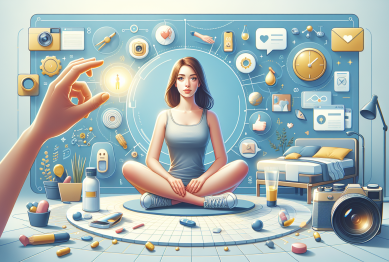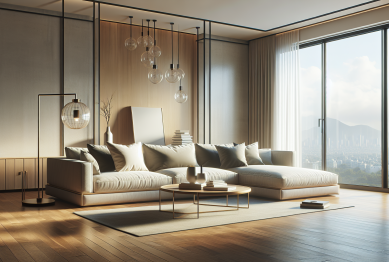Curious about lifestyle changes that can instantly shift your daily experience? Explore fresh minimalism trends in home design, digital spaces, fashion, and even social routines. Learn how small lifestyle shifts can create space—physically and mentally—for the things that matter most.
Rethinking Spaces: Minimalism at Home
Minimalist home design has evolved beyond bare walls and monochrome palettes. New takes on minimalism center on creating functional, calming environments with just the essentials. This approach is about intention—prioritizing meaningful objects, natural light, and open floor plans. The movement now embraces warm textures and soft materials, making spaces both streamlined and welcoming. By letting go of clutter and embracing simplicity, homeowners discover more room for relaxation and creativity. Minimalist interiors often rely on multi-function furniture, thoughtful storage, and soothing color schemes to support a sense of calm and focus (Source: ArchDaily).
Many are turning to eco-friendly materials—bamboo, recycled glass, and organic fabrics—to create minimal living spaces that are also sustainable. The conscious use of fewer resources aligns this trend with a growing awareness of environmental impact. By choosing high-quality, long-lasting items, people find themselves purchasing less and saving money over time. Each piece becomes a statement, valued for its craftsmanship and purpose. This eco-minimalist approach sets the tone for mindful consumption and responsible living.
Minimalism doesn’t mean eliminating all décor. The latest styles encourage personality through curated galleries of art, handmade pottery, or vibrant plants. The key is to let every object earn its place. This makes each element more noticeable, and the visual breathing room enhances appreciation. Adapting minimalism to your own taste—rather than a strict formula—allows for flexibility, self-expression, and ongoing refreshes as life evolves. Minimalist home design is a foundation for a more intentional way of living that extends far beyond four walls.
Minimalist Fashion: Quality Over Quantity
Capsule wardrobes are reshaping the way fashion enthusiasts approach shopping. This minimalism trend focuses on assembling a small collection of versatile pieces that can be mixed and matched across seasons. By investing in quality staples—think tailored jeans, crisp shirts, and elegant jackets—closets become streamlined, and daily outfit choice is simplified. This practice can lessen decision fatigue, save time each morning, and support more sustainable consumer habits as well (Source: Vogue).
The color palette most often associated with minimalist style—neutrals, earth tones, and soft whites—remains popular, but bold accessories are making a subtle return. Choosing a statement belt, unique bag, or signature pair of shoes ensures personal style isn’t lost among simple lines and classic forms. Minimalist fashion encourages people to invest in well-constructed garments, highlighting the beauty of natural fabrics while shifting the focus from fast fashion to timeless appeal. Many report that their shopping habits change drastically, with more reflection before purchasing and greater satisfaction with what they do own.
Minimalism in fashion is also being driven by brand transparency and ethical manufacturing. Shoppers want to know the origins of their clothing—who made it, how, and with what materials. This alignment of personal values and wardrobe choices brings fulfillment and a sense of participation in positive global shifts. Clothes, in this sense, become meaningful. Minimalist wardrobes serve as both a practical solution to overconsumption and a statement about thoughtful living—and the difference can be felt every time a favorite outfit is worn.
Digital Declutter: Simplifying Screen Time
Digital minimalism has grown as people reassess how much time and mental bandwidth is spent on devices. The trend urges a careful review of apps, notifications, and daily media consumption. Uninstalling unused apps, organizing files, and prioritizing only essential technologies can boost focus and ease digital overwhelm. With notifications silenced or customized, the constant pull of smartphones becomes less intrusive, freeing up energy for creativity, real-world connections, and mindful routines (Source: New York Times).
New approaches in digital minimalism support setting intentional online routines. People are turning to designated “tech-free hours”—often during meals or before bed. Others choose “social media fasts” or keep their home screens minimal with only a handful of productive applications. These strategies help reduce stress and the negative effects of overexposure to news, advertising, and information overload. A digital detox can reveal just how much space is reclaimed for hobbies, reading, or quiet reflection.
Some are extending this concept by embracing analog hobbies like journaling or sketching, finding calm and focus away from screens. Even digital professionals adopt minimalist browser setups, limiting open tabs and curtailing constant multitasking. The result isn’t just cleaner desktops or phones—it’s improved mental health, better sleep, and more time for meaningful activities. Digital minimalism is no longer a niche experiment; it’s becoming an adaptive, everyday practice in a hyper-connected world.
Mindful Entertainment: More With Less
Entertainment habits are shifting—many are choosing fewer but richer experiences instead of trying to consume everything at once. This minimal approach might mean reducing subscriptions, curating watchlists, or planning intentional movie nights with friends. By prioritizing quality programming or live performances, enjoyment is heightened and social connections deepen. Streaming services have even responded by providing tools to help users manage their content diets, inspiring viewers to savor rather than binge (Source: TechRadar).
Reading is enjoying a renaissance in the minimalist mindset. Instead of overflowing shelves or endless digital downloads, individuals focus on select books that resonate and inspire. The rise of local library memberships, book swaps, and minimalist book clubs offers more connection with less material. This trend reflects a core idea of minimalism: depth and presence over volume. Slower consumption leads to richer discussions, stronger retention, and a deeper bond to content.
Similarly, music fans may create intentional playlists, fostering genuine listening sessions rather than background noise. Live performances—whether cozy local gigs or streamed concerts—offer meaningful interaction and lasting memories. Minimalist entertainment isn’t about deprivation; it’s a celebration of abundance through selectivity. By saying “no” to constant stimulation, people discover which experiences move them most and create space for discovery and joy.
Minimalism in Social Life: Fewer, Deeper Connections
Social minimalism changes how people approach relationships and routines. Rather than maintaining large networks, there’s a growing preference for fewer but more meaningful friendships. This trend extends to event planning as well—smaller gatherings, intimate dinners, or technology-free meetups take center stage. The result: less pressure to keep up and a greater opportunity to foster authentic connection and shared memory-making. Social minimalists often report feeling more at ease, present, and supported (Source: Psychology Today).
Boundary-setting also becomes central. Minimalists find that politely declining invitations and limiting digital contact free up time for rest, hobbies, or self-development. This recalibration lets people show up more fully where it matters most, whether that means family, close friends, or solo time. Freedom from constant social obligations enables reflection and a clearer sense of priorities. The end goal is not isolation but balance—an often-overlooked ingredient in well-being.
Even the way we celebrate is changing. Intentional minimalism shines during holidays, where giving experiences or handmade gifts overshadows large material exchanges. People are experimenting with “no-gift” gatherings, shared meals, or group activities that prioritize connection and creativity. These traditions bring new energy to familiar rituals, celebrating what truly matters. The trend suggests that less, done meaningfully, can be more memorable—and more fulfilling—than a busy calendar filled with obligations.
Wellness and the Minimalist Mindset
Minimalism fits naturally with wellness by emphasizing routines that support mental clarity and physical health. This can look like clearing space for meditation, simplifying meal planning, or reducing the number of fitness gadgets. By focusing on essentials, routines become easier to maintain, lowering stress and creating time for what’s truly beneficial. Wellness minimalists often favor fewer but higher-quality self-care practices over chasing every new trend (Source: Healthline).
Physical decluttering has proven links to lower cortisol levels, sharper focus, and improved sleep. The process of letting go of excess—be it possessions, toxic routines, or unrealistic expectations—actually supports deeper relaxation and joy. Simple habits like yoga, walks in nature, or mindful breathing become anchors amidst daily busyness. Minimalism, then, offers tangible health perks for both body and mind, backed by research and first-hand accounts from those who’ve made the switch.
Wellness isn’t just personal. Minimalists often extend these principles into community living, supporting causes, or volunteering. By saying yes only to what feels aligned, there’s more energy left for kindness and generosity. This ripple effect colors interactions and uplifts the surrounding environment, creating broader benefits. Minimalist wellness demonstrates that living with less isn’t a sacrifice—it’s an investment in clarity, fulfillment, and overall happiness.
References
1. ArchDaily. (2022). Minimalism in Interior Design: 8 Tips and Examples. Retrieved from https://www.archdaily.com/981521/minimalism-in-interior-design-8-tips-and-examples
2. Vogue. (2023). How to Build a Capsule Wardrobe, According to Experts. Retrieved from https://www.vogue.com/article/how-to-create-capsule-wardrobe-guide
3. New York Times. (2022). Digital Declutter: How to Simplify Your Life Online. Retrieved from https://www.nytimes.com/guide/goodtech/digital-declutter
4. TechRadar. (2023). How to declutter your streaming: A guide to managing your services. Retrieved from https://www.techradar.com/how-to/how-to-declutter-your-streaming-services
5. Psychology Today. (2019). Minimalism and Its Impact on Your Social Health. Retrieved from https://www.psychologytoday.com/us/blog/the-moment-youth/201903/minimalism-and-its-impact-your-social-health
6. Healthline. (2021). 8 Minimalism Benefits for Your Mental Health and Well-Being. Retrieved from https://www.healthline.com/health/mental-health/minimalism-benefits









